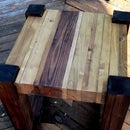Introduction: Hexagon Deck With Recycled Supplies
I had a vision of a Hexagon deck. So a decision was made to make it a reality. We have several hexagon plant beds and a hexagon table, so why not a hexagon deck?! :)
Supplies:
1. Tons of scrap and recycled wood. 2x4's, 2x6's, 2x8's. I scavanged, collected and got together enough wood to start the project.
2. Some 1/16" aluminum (equivalent to 3'x3' in pieces)
3. Nails of every sort
4. Some deck screws (not too many though)
5. Wood Glue
6. Two gallons of Thompsons water sealer
7. Some roofing tar paper scraps
I started with the recycled wood creating a framing. I didn't choose a size, I simply based it on the largest 6 pieces of wood I had and simply cut 30 degree facing cuts on the outside of the boards. I used Thompson water sealer with a tint to seal up the wood (a mixture of pressure treated and non-pressure treated wood, so we sealed every corner and cut before putting it together)
Step 1: The Framing
I screwed the 30 degree angles together and then took some of the scrap aluminum to connect the outside frame with the internal supports. Without planning it ended up with a cool looking arrow on each corner.
I used scrap galvanized roofing nails and glue to adhere the aluminum and wood together.
The only measurements done were to make sure the lengths of wood were the same length. At one point I just used a piece of wire to measure to save time (and because I kept losing my measuring tape!).
I used the tar paper under each 2x4 and I added an extra 2x4 between each long beam to add support as it felt a little soft upon first steps. So there were 12 boards under the frame in the end. The extra 6 were only 5 feet long pointing towards the center (pictured).
In my case the deck had to be very low to the ground due to the height of the house, that is why the framing boards are on their side, you could turn them upright and get a few extra inches off the ground.
For the center piece where the support beams come together I simply did a rough spacing between the boards and placed a piece of aluminum over the top and nailed the pieces together with roofing nails and glue.
Step 2: Building the Deck
I started with brand new 2x6's on the outside edge to make sure they were strong and straight. I did each cut visually without a measuring tape. Once the first one was nailed in, I went on the the next board, simply putting it down and marking where the next 30 degree cut will go. I will admit I cut a few of them backwards along the way, but no matter, it was used later on in the build since the boards got smaller and smaller as we continued the build.
After the first set was cut, sealed and nailed we did 6 boards (one time around) at a time.
I would cut the boards to length and cut them individually and tap them in with a hammer (no nails yet!)
Then Alyson would sand each board top and stain/seal all the way around.
An hour later the boards would come back to me for installation. I marked them with numbers before pulling them up so that I knew where each board went EXACTLY (important). Since there was no meauring, the boards were all slightly different and it gave the deck character in my humble opinion and I didn't have to measure every 20 seconds.
109 boards make up this deck top. I treated it like a meditation of sorts, enjoying the steps of making the hexagon hole smaller and smaller over about a week, working a couple hours a day.
Step 3: Closing the Gap
About 2/3's of the way through I ran out of scrap wood. The design I chose was to do 2 2x4 beams and then a 2x6 or 2x8 beam to break up the design. So I was off to home depot to buy some treated and untreated lumber. I kept it fairly random in what I used to keep the color and texture of the wood changing.
Step 4: And Suddenly a Pretty Deck Appeared!
After about a week or ten days, the deck was completed. I used left-over nails from a flooring job (and an air gun). It probably took over 1000 nails to do the securing. Then we resealed the entire deck one last time to protect the non-galvanized nails (that were free) as they would rust without a little TLC. The deck ended up being approximately 16 feet across using 8 foot boards in the beginning for the frame.
A fun project and a pretty nice looking deck! yay!
The actual out of pocket expense was probably under $200, but I was building other stuff at the same time, so can't be sure.
*All of the nails were scrap, 2/3's of the wood was scrap (all the pretty dark wood was scrap), the tar paper was scrap, the aluminum was scrap.






